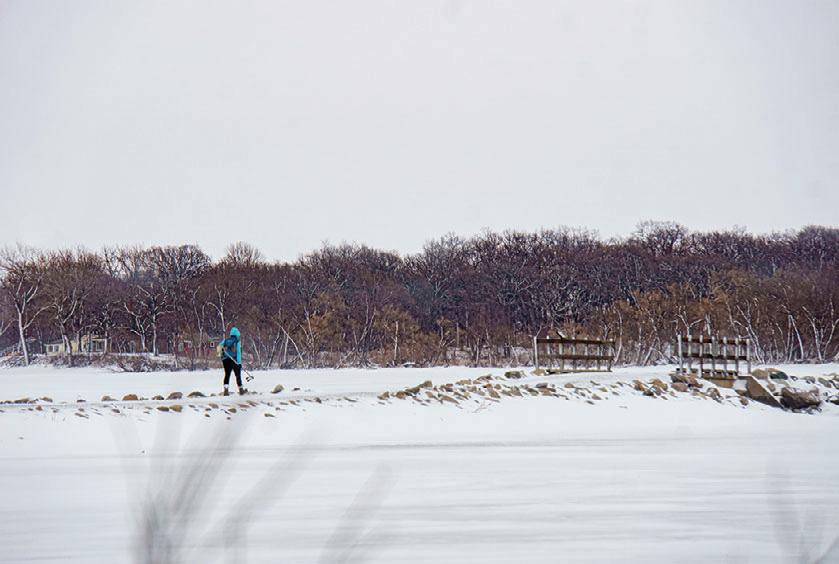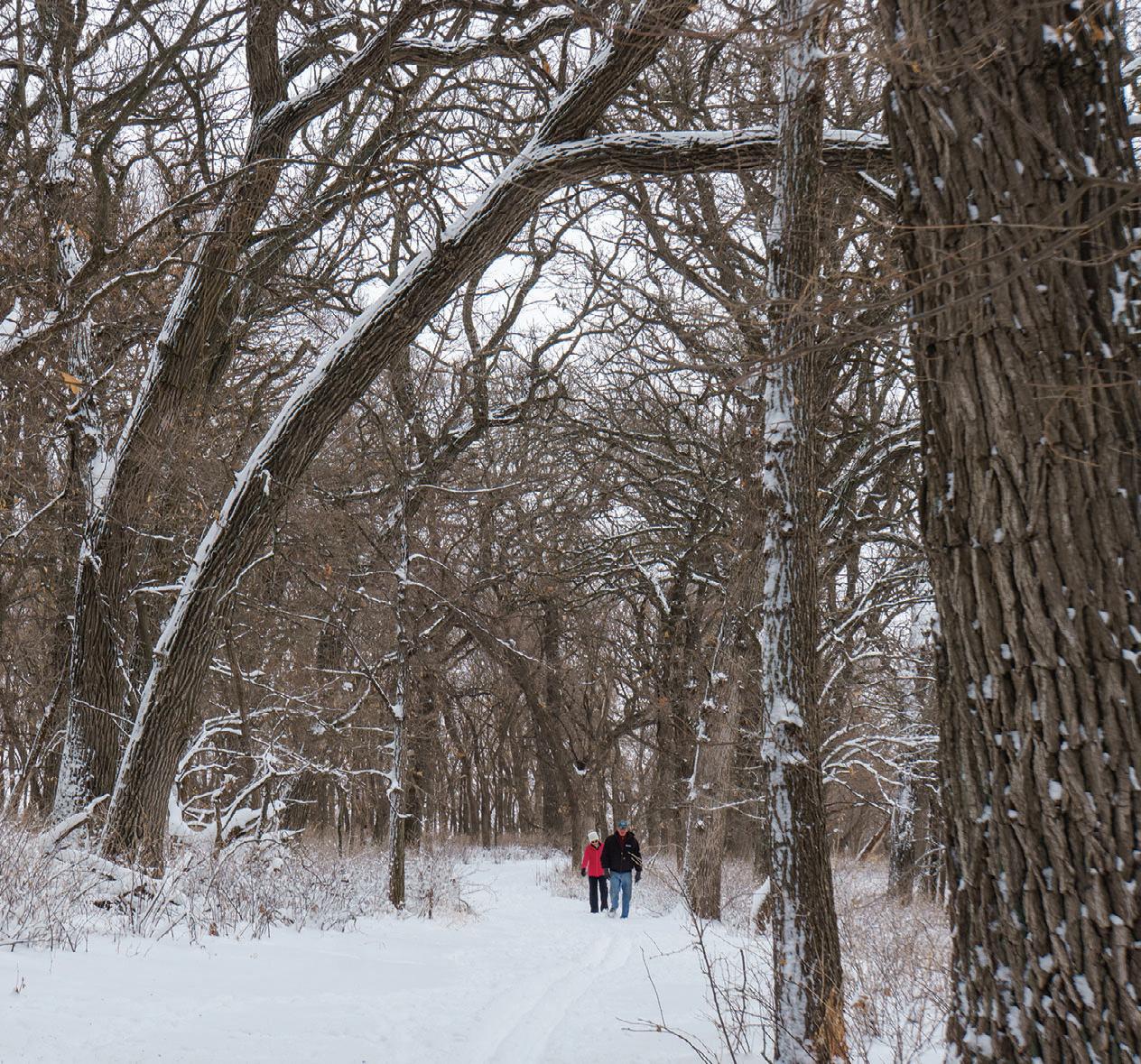
5 minute read
Weekend at Lake Shetek State Park
Story and photos by Jan Lasar
With just over 1,100 acres, Lake Shetek State Park in Currie, MN is a smaller park in Minnesota’s system. In fact, the lake it’s named after is three times bigger and is the main attraction for many visitors. Tucked into the southwestern corner of the state, some 40 miles from South Dakota and 20 miles from Iowa, the lake draws visitors into Minnesota from several states. Things settle down during the cold months, but the 14-mile trail network still gives you plenty to explore. On a cold January day, we paid a visit and stayed in one of the park’s camper cabins.
We arrived in time to watch park staff dig out our cabin from under eight inches of snow. When they were done, we wasted no time, moved in, strapped on the snowshoes and went for a hike. Lucky for us, Picnic Trail passed right by our cabin and went north past the beach and the boat landing to the Loon Island Causeway. It was about 20 degrees with a stiff breeze coming off the frozen lake. The trail was mostly covered in snow, but a blizzard with 40 and 50 miles per hour wind gusts had deposited huge drifts that snaked like white fingers across the trail, some several feet thick. That’s what snowshoes are for and we got a kick out of hustling up the drifts one side and yelling “Wheee!” on the other side, like we were descending a mountain on skis.

Loon Island Causeway
The causeway is a narrow land bridge between the state park and Loon Island with a 1,000-foot span. Here, the icy winds were howling across the skinny trail and made our eyes water. Snowshoes were useless on this stretch, because there was not a flake of snow here. We took them off and hurried across the bay. Just before we reached the island, however, it was like someone had turned off the wind tunnel machine. One second we were leaning into the arctic blast, the next minute the wind had stopped completely as if on command. Not even the grasses next to us moved. I took a few steps back and there was the wind again, in full force.
Loon Island isn’t huge and the hiking trail that circles it is less than a mile long, but it’s defi nitely worth it. Interpretive signs will tell you about the area’s natural history and what makes Loon Island so special. The first thing you’ll learn is that Loon Island is a misnomer because people mistook the cormorants that used to nest here, for loons. You’d expect this to be a haven for cormorants, but the colony was wiped out by a special hunt, staged by area residents in the early 1900s, who felt the birds were eating too much fish from the lake. This story makes a great argument for outdoor education and preservation, but then again, humans built the causeway we walked to get to the island to read the signs that told us how humans interfered in nature.
The walk around the island was invigorating. We had fi rst tracks through some thick drifts and trees and bushes were coated with puffy snow on the side that had faced the blizzard. It looked like fake spray snow, the kind you’d find in department store displays. It was a great snowshoe hike through basswood and hackberry forest that blocked the wind and allowed us to marvel at a beautiful winter landscape. Back at the cabin, Jen checked her Avenza tracker. We had managed to get in three miles, which was not bad for an afternoon.

Bluebird Trail
The next day we got going a little earlier, planned for a longer trek on snowshoes and were looking forward to a high temperature of around 30 degrees. Leaving from our cabin again, we headed east this time, on Monument Trail. Snowmobiles had fl attened out most of the drifts, so the going was a little easier this time around. The Lake Shetek Monument the trail is named after, marks the graves of 15 settlers who were killed by Dakota warriors in 1862. (To learn more about the US-Dakota war, visit www.usdakotawar.org) Here, we turned east to round the northern edge of Smith Lake, then north after getting on the Bluebird Trail. We fully expected to get a full blast of cold air on the Bluebird Trail since it goes north through wide-open prairie and it was a windy day.

Shetek Monument

Lake Side Trail
As soon as we stepped on the trail, however, the sun broke out from behind grey clouds and the wind turned out not to be a big deal as we soaked up the rays. We stopped briefl y to take in the views of Eastlick Marsh from a raised platform and headed back into the woods to take a break at the group camp area. My favorite part of winter trail breaks is the little stove I made from two pop cans, with YouTube instructions. The whole kit, fuel, coffee, fi lter, stand and a windscreen packs into a little pot and within 10 minutes we had a pint of steaming, hot coffee. We continued on the Park Lake Trail where we passed by the former site of a settler’s cabin-now just a depression in the frozen ground-and fl ushed out a herd of deer, that scattered across Park Lake, some two dozen strong.

Koch Sttler's Cabin

One of four camper cabins at the park
After making the connection to Lake Side Trail on the other side of Park Lake, we shoed through a winter wonderland with deep snows, followed by another half mile of huge drifts and some of the biggest cottonwood trees we’ve ever seen. We turned back south on Fish Pond Trail and from there bushwhacked our way past the Koch pioneer cabin back to our cabin. An hour later we had a fire going and enjoyed the last bit of daylight and mild temps. We watched the sun go down over Lake Shetek while the fl ames danced in the fire pit. As dusk came, the lights in the houses across the lake blinked on one by one while we enjoyed another quiet night in our own palace for rent.

